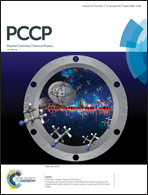Pentagonal five-center four-electron π bond in ternary B3N2H5 cluster: an extension of the concept of three-center four-electron ω bond†
Abstract
Boron-based heteroatomic rings can have exotic chemical bonding, in which the p lone-pairs of heteroatoms manage to participate in delocalized π bonding, compensating for boron's electron-deficiency. We explore herein the bonding properties of ternary B–N–H systems with a pentagonal ring, using the B3N2H50/−/2− clusters as examples. Computational structural searches lead to perfectly planar C2v B3N2H5 (1, 1A1) and C2v B3N2H5− (2, 2B1) as global minima for the neutral species and monoanion, which feature a pentagonal B3N2 ring. The corresponding dianion C2v B3N2H52− (3, 1A1) is a local minimum, whose global minimum adopts a chain-like open structure. Bonding analyses reveal a five-center four-electron (5c–4e) π system in 1, dubbed the 5c–4e o-bond. It is a 4π system in the bonding/nonbonding combination, originating from two N 2p lone-pairs, which can be considered as an extension of the concept of 3c–4e ω-bond. The extra electrons in 2 and 3 occupy a markedly destabilized π orbital. Thus, a 4π configuration, rather than a π sextet according to the (4n + 2) Hückel rule, is electronically robust for the B3N2H50/−/2− system. Infrared and photoelectron spectra are predicted for 1 and 2, respectively. Structural evolution of ring-like and chain-like isomers with charge-state in B3N2H50/−/2− is elucidated. B3N2H5− (2) is used as ligand for sandwich-type complexes: C2h [(B3N2H5)2Fe]2− and C2h [(B3N2H5)2Fe]Li2.



 Please wait while we load your content...
Please wait while we load your content...